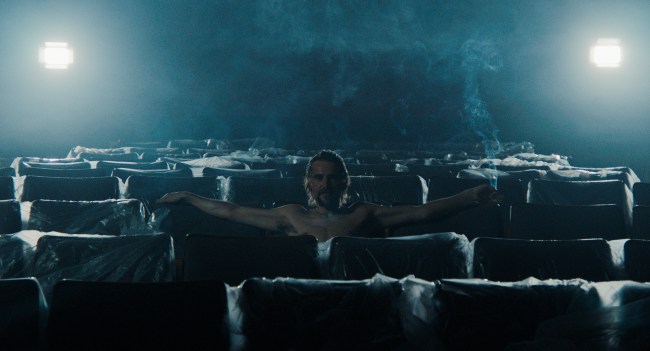From a solitary photographer capturing desert rock formations to abandoned movie theaters housing unexpected evils, Joshua Erkman’s directorial debut “A Desert” is consistently preoccupied with images and the people who devote their lives to making them. A nightmarish road trip film that wears its Hitchcock influences on its sleeve, the film follows a once-acclaimed photographer (Kai Lennox) who tries to manufacture a spark of creativity by driving through the American Southwest without a cell phone to comb through the scenery that used to inspire him so much.
The film, which premiered at Tribeca in 2024 and opens in theaters this weekend, feels like the launch of a promising new genre filmmaker. Erkman’s road to his directorial debut was a long one, as he spent much of his previous career working on restorations of classic films. The director explained that this project was a direct result of a life that has afforded him endless amounts of time to spend studying the nuances of cinema.
“I kind of like to think of it as this neo-noir that’s just as much about movies and the craft of image making as anything that happens in the plot of the movie,” Erkman said during a recent interview with IndieWire.
After attending USC film school, Erkman’s career began in the quality control department of a DVD company, where he would spend eight hours a day watching the same movies on a loop in search of manufacturing imperfections.
“As a cinephile, getting to see the same movies again and again and again, you see things you didn’t notice before,” he said. “You’re looking at it not just as a viewer, but through the lens of ‘What is technically wrong with it?’ It just further fueled this movie obsession that I had.”
From there, Erkman ended up in the niche field of film restoration, working with the likes of Criterion, Arrow, and Vinegar Syndrome to restore negatives of classic films such as William Friedkin’s “Sorcerer” for new physical releases. It’s a field that has forced him to study cinema’s masterpieces at a skeletal level, giving him a unique perspective on how to structure movies.
“Some of the work in mastery and restoration that I’ve done over the years, so much of it is about attention to detail,” he said. “Especially with some of the mechanics of movies. You see the same thing again and again and again, and you start to subtract ‘How is this working story-wise or emotionally?’ and it just becomes ‘It’s this shot or it’s that shot.’ And there’s something very interesting when you start to deconstruct a movie. You see a little bit of how it’s made, and I think as a filmmaker that stuff has been really helpful.”
Erkman has directed music videos and short films for years, but “A Desert” marked his first plunge into feature filmmaking. He initially had the idea to make a film about a photographer traversing the deserts of America on his own, but didn’t have a specific story in mind. Instead, he spent years developing what became Lennox’s character by producing a massive photo album of his own. Erkman would spend his weekends driving through desert backroads in search of interesting scenery, and slowly gravitated towards the kinds of landmarks that he imagined would interest a photographer going through a midlife crisis. Those drives eventually led him to discover the focal point of his movie: abandoned movie theaters that are home to passion and evil in equal measures.
“I thought, ‘Let me just start building this guy’s body of work,’” he said. “Let me be this character, let me find these places, and that informed what the script eventually became. I kept coming across these old movie theaters, abandoned movie theaters, drive-in movie theaters. It just got me thinking ‘maybe there’s something here.’”
“A Desert” is both a convincing horror film and a reference-filled tribute to classic cinema. It’s likely to appeal to both genre fanatics and noir historians in equal measure. In many ways, the film Erkman made is a direct result of his background in film restoration, both in terms of his protagonist’s obsession with photography and the craftsmanship he learned while spending endless hours looking at old 35mm prints. He explained that watching footage from classic films in various stages of completion gave him a bird’s-eye view of the process that left him uniquely prepared to direct his own work.
“There’s a project recently that I worked on. It’s one of my favorite movies, I’ve seen it a bunch of times,” he said. “And I was sitting there with the colorist, and he was saying ‘Damn, this is really complicated.’ I was like, ‘What do you mean?’ He said, ‘There’s very few repeated shots in this movie.’ One way that you would cover a conversation between people would be shot-reverse shot. This movie had none of that. Every shot was a new shot, so it was very time-consuming to get the color to match, because you can’t duplicate any of your previous work you’ve already done.”
He continued, “Things like that, where you’re like, ‘I’ve seen this movie a billion times, I know it inside and out.’ Or I thought I did. But then you see it with no sound, you talk about the color on it, and it starts to open your mind to see what you can do with the medium.”
A Dark Sky release, “A Desert” is now playing in select theaters.



